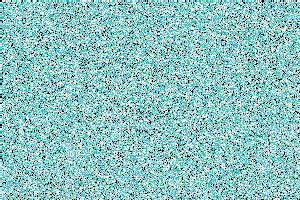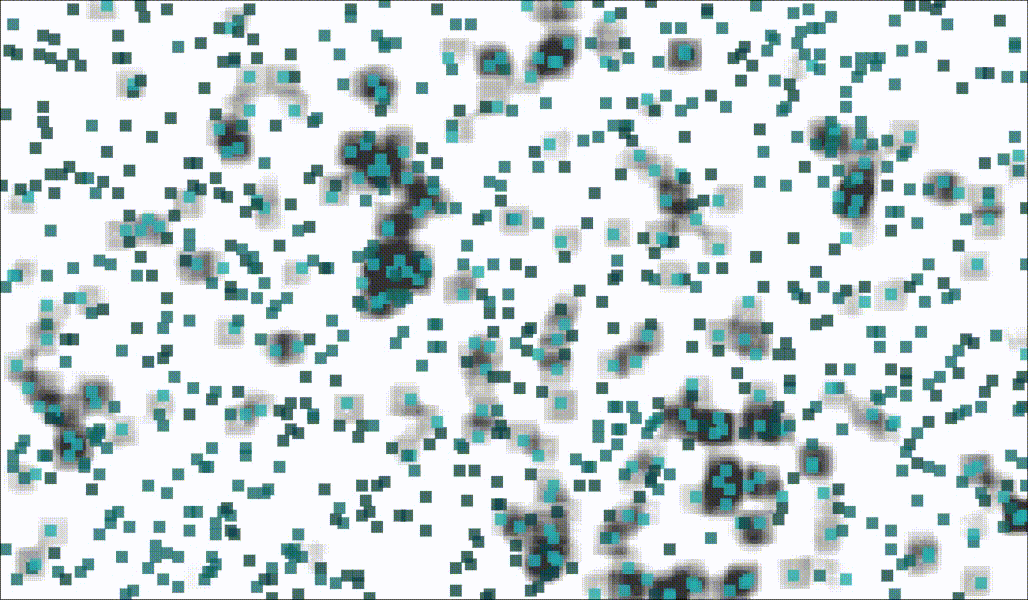Cellular automata and agent-based models

Cellular automata (CA) consist of a grid of cells, each of which can be in one of a finite number of states. The grid evolves over discrete time steps based on a set of rules that determine the new state of each cell as a function of its current state and the states of its neighboring cells. As such, a CA constitutes a discrete-space, discrete-time dynamical system with a local and homogeneous evolution rule. Our foundational and computational study of CA offers invaluable insights into emergent complex behavior arising from simple rules. We do this by resorting to Lyapunov exponents, sensitivity and entropy measures, and so on.
Agent-based models are spatially explicit and constructed bottom-up. Essentially, they describe processes at micro level, while patterns at macro level emerge spontaneously by simulation of the processes at micro level.
Epidemic models

Since the COVID pandemic we have been strengthening our expertise in developing and operationalizing spatially explicit epidemic models whose scope stretches beyond the one of classical infectious disease models. Especially, we integrate the latter holistically with (health) economic models in order to get a comprehensive overview of the impacts of infectious diseases and the consequent containment and mitigation measures on the society as a whole.
Models of cell cultures and living tissues

We study and develop Agent-based Models to simulate growth of cells in in-vitro and in-vivo environments ( bacterial biofilms, tumors, organoids, tissues) in order to understand fundamental cues, environmental factors and interaction mechanisms in the organisms, that drive tissue formation and diversification. We are further interested in models that can predict production rates of biologics (e.g. antibodies) by cells in bioreactors as well as the control thereof (e.g. Model Predictive Control).
Models of discrete matter dynamics and complex fluids

We develop particle-based models (Discrete Element Methods, SPH) to simulate complex fluids or powder flows Examples: granular matter processes in pharmaceutical devices, viscoelastic fluids, .. Our focus is on the understanding of particle flow and aggregation.
Spatially explicit ecological models

Even though ecological modelling is pervaded by models based on (partial) differential equations, the mean-field assumptions on which these are based often jeopardize their usefulness when there are few individuals, spatial and/or individual heterogeneity are into play, or evolution plays an important role. In those cases, we should resort to spatially explicit models, such as, individual-based modelling paradigms. Over the years, we have acquired the expertise that is needed to develop and deploy such models, often with the goal to answer specific policy or management questions. For instance, we we have set up and deployed such models for migratory fish species, fungal growth, species interaction, marine communities, and so on.

Cellular automata (CA) consist of a grid of cells, each of which can be in one of a finite number of states. The grid evolves over discrete time steps based on a set of rules that determine the new state of each cell as a function of its current state and the states of its neighboring cells. As such, a CA constitutes a discrete-space, discrete-time dynamical system with a local and homogeneous evolution rule. Our foundational and computational study of CA offers invaluable insights into emergent complex behavior arising from simple rules. We do this by resorting to Lyapunov exponents, sensitivity and entropy measures, and so on.
Agent-based models are spatially explicit and constructed bottom-up. Essentially, they describe processes at micro level, while patterns at macro level emerge spontaneously by simulation of the processes at micro level.
Epidemic models

Since the COVID pandemic we have been strengthening our expertise in developing and operationalizing spatially explicit epidemic models whose scope stretches beyond the one of classical infectious disease models. Especially, we integrate the latter holistically with (health) economic models in order to get a comprehensive overview of the impacts of infectious diseases and the consequent containment and mitigation measures on the society as a whole.
Models of cell cultures and living tissues

We study and develop Agent-based Models to simulate growth of cells in in-vitro and in-vivo environments ( bacterial biofilms, tumors, organoids, tissues) in order to understand fundamental cues, environmental factors and interaction mechanisms in the organisms, that drive tissue formation and diversification. We are further interested in models that can predict production rates of biologics (e.g. antibodies) by cells in bioreactors as well as the control thereof (e.g. Model Predictive Control).
Models of discrete matter dynamics and complex fluids

We develop particle-based models (Discrete Element Methods, SPH) to simulate complex fluids or powder flows Examples: granular matter processes in pharmaceutical devices, viscoelastic fluids, .. Our focus is on the understanding of particle flow and aggregation.
Spatially explicit ecological models

Even though ecological modelling is pervaded by models based on (partial) differential equations, the mean-field assumptions on which these are based often jeopardize their usefulness when there are few individuals, spatial and/or individual heterogeneity are into play, or evolution plays an important role. In those cases, we should resort to spatially explicit models, such as, individual-based modelling paradigms. Over the years, we have acquired the expertise that is needed to develop and deploy such models, often with the goal to answer specific policy or management questions. For instance, we we have set up and deployed such models for migratory fish species, fungal growth, species interaction, marine communities, and so on.

Since the COVID pandemic we have been strengthening our expertise in developing and operationalizing spatially explicit epidemic models whose scope stretches beyond the one of classical infectious disease models. Especially, we integrate the latter holistically with (health) economic models in order to get a comprehensive overview of the impacts of infectious diseases and the consequent containment and mitigation measures on the society as a whole.
Models of cell cultures and living tissues

We study and develop Agent-based Models to simulate growth of cells in in-vitro and in-vivo environments ( bacterial biofilms, tumors, organoids, tissues) in order to understand fundamental cues, environmental factors and interaction mechanisms in the organisms, that drive tissue formation and diversification. We are further interested in models that can predict production rates of biologics (e.g. antibodies) by cells in bioreactors as well as the control thereof (e.g. Model Predictive Control).
Models of discrete matter dynamics and complex fluids

We develop particle-based models (Discrete Element Methods, SPH) to simulate complex fluids or powder flows Examples: granular matter processes in pharmaceutical devices, viscoelastic fluids, .. Our focus is on the understanding of particle flow and aggregation.
Spatially explicit ecological models

Even though ecological modelling is pervaded by models based on (partial) differential equations, the mean-field assumptions on which these are based often jeopardize their usefulness when there are few individuals, spatial and/or individual heterogeneity are into play, or evolution plays an important role. In those cases, we should resort to spatially explicit models, such as, individual-based modelling paradigms. Over the years, we have acquired the expertise that is needed to develop and deploy such models, often with the goal to answer specific policy or management questions. For instance, we we have set up and deployed such models for migratory fish species, fungal growth, species interaction, marine communities, and so on.

We study and develop Agent-based Models to simulate growth of cells in in-vitro and in-vivo environments ( bacterial biofilms, tumors, organoids, tissues) in order to understand fundamental cues, environmental factors and interaction mechanisms in the organisms, that drive tissue formation and diversification. We are further interested in models that can predict production rates of biologics (e.g. antibodies) by cells in bioreactors as well as the control thereof (e.g. Model Predictive Control).
Models of discrete matter dynamics and complex fluids

We develop particle-based models (Discrete Element Methods, SPH) to simulate complex fluids or powder flows Examples: granular matter processes in pharmaceutical devices, viscoelastic fluids, .. Our focus is on the understanding of particle flow and aggregation.
Spatially explicit ecological models

Even though ecological modelling is pervaded by models based on (partial) differential equations, the mean-field assumptions on which these are based often jeopardize their usefulness when there are few individuals, spatial and/or individual heterogeneity are into play, or evolution plays an important role. In those cases, we should resort to spatially explicit models, such as, individual-based modelling paradigms. Over the years, we have acquired the expertise that is needed to develop and deploy such models, often with the goal to answer specific policy or management questions. For instance, we we have set up and deployed such models for migratory fish species, fungal growth, species interaction, marine communities, and so on.

We develop particle-based models (Discrete Element Methods, SPH) to simulate complex fluids or powder flows Examples: granular matter processes in pharmaceutical devices, viscoelastic fluids, .. Our focus is on the understanding of particle flow and aggregation.
Spatially explicit ecological models

Even though ecological modelling is pervaded by models based on (partial) differential equations, the mean-field assumptions on which these are based often jeopardize their usefulness when there are few individuals, spatial and/or individual heterogeneity are into play, or evolution plays an important role. In those cases, we should resort to spatially explicit models, such as, individual-based modelling paradigms. Over the years, we have acquired the expertise that is needed to develop and deploy such models, often with the goal to answer specific policy or management questions. For instance, we we have set up and deployed such models for migratory fish species, fungal growth, species interaction, marine communities, and so on.

Even though ecological modelling is pervaded by models based on (partial) differential equations, the mean-field assumptions on which these are based often jeopardize their usefulness when there are few individuals, spatial and/or individual heterogeneity are into play, or evolution plays an important role. In those cases, we should resort to spatially explicit models, such as, individual-based modelling paradigms. Over the years, we have acquired the expertise that is needed to develop and deploy such models, often with the goal to answer specific policy or management questions. For instance, we we have set up and deployed such models for migratory fish species, fungal growth, species interaction, marine communities, and so on.